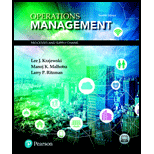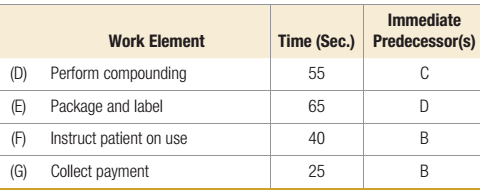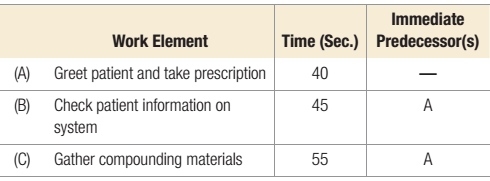
Concept explainers
Quick Stop Pharmacy is a small family-owned, drug-compounding business in Portland, Oregon, that is trying to perfect its customer service operations. The owner, John Suleiman, wants to maximize the productivity of his staff as well as serve customers well. One area of concern is the drive-thru operation during the 7:30–8:30 morning rush hour. The process of fulfilling an order is as follows:

- If all the steps are handled by one employee, how many patients could be served per hour?
- If James wants to process 30 patients per hour, how many employees will he need?
- How many stations are required using the longest work element decision rule?
- Using the solution developed in part (c), which station is the bottleneck and how large is its capacity cushion?

Want to see the full answer?
Check out a sample textbook solution
Chapter 5 Solutions
Operations Management: Processes and Supply Chains (12th Edition) (What's New in Operations Management)
Additional Business Textbook Solutions
Loose-leaf for Operations Management (The Mcgraw-hill Series in Operations and Decision Sciences)
Operations Management
Principles of Operations Management: Sustainability and Supply Chain Management (10th Edition)
Principles Of Operations Management
Business in Action (8th Edition)
Business in Action
- Teddy Fields is the Kitchen Manager at the Tanron Corporation International Headquarters. The facility he helps manage serves 3000 employees per day. Teddy very much needs an additional dishwasher, and is interviewing Wayne, an excellent candidate with 5 years experience who is now washing dishes at the Roadway restaurant. Teddy normally starts his dishwashers at $12.00 per hour. Wayne states that he makes $13.00 per hour, a rate that is higher than all but one of Teddy’s current dishwashers. Wayne states that he would not leave his current job to take a “pay-cut”. Should Teddy offer to hire Wayne at a rate higher than most of his current employees? Why or why not?arrow_forwardcreate an exercise involving obtaining parts per hour of work. Example: (This is an example, do not answer) A factory that produces computer mice works in a quiet and regular manner since it does not sell its product to large companies, nor is its demand very variable.It produces 280 mice per month, of which 270 are conforming products. In October 2019, 23 days were worked. Its standard operating time is 7 hours a day, with a 30-minute lunch break. In addition, in the mornings the machines must be allowed to warm up for 20 minutes. The machines are operated in this manner from Monday to Friday. When they reach the production of 250 mice, they take a "break" to review the production so far. This waiting time (kanban) takes them 4 hours. Determine the total number of parts produced during the month of October 2019. Now, create another example of parts per hour of work:arrow_forwardA company that makes shopping carts for supermarkets and other stores recently purchased some new equipment that reduces the labor content of the jobs needed to produce the shopping carts. Prior to buying the new equipment, the company used 5 workers, who together produced an average of 90 carts per hour. Workers receive $13 per hour, and machine cost was $50 per hour. With the new equipment, it was possible to transfer one of the workers to another department, and equipment cost increased by $11 per hour while output increased by 5 carts per hour. a. Compute labor productivity under each system. Use carts per worker per hour as the measure of labor productivity. (Round your answers to 3 decimal places.) Before carts per worker per hour After carts per worker per hour b. Compute the multifactor productivity under each system. Use carts per dollar cost (labor plus equipment) as the measure. (Round your answers to 3 decimal places.) Before carts/dollar cost…arrow_forward
- Teddy Fields is the kitchen manager at the Tanron Corporation International Headquarters. The facility he helps manage serves 3,000 employees per day. Teddy very much needs an additional dishwasher. He is now interviewing Wayne, who is an excellent candidate with five years of experience and who is now washing dishes at the nearby Roadway restaurant. Teddy normally starts his new dishwashers at $12.00 per hour. Wayne states that he currently makes $13.25 per hour; a rate that is higher than all but one of Teddy's current dishwashers. Wayne states that he simply will not leave his current job to take a “pay cut.” Should Teddy offer to hire Wayne at a rate higher than most of his current employees? Why or why not? (2 paragraphs)arrow_forwardThe boss at the Precision Machine Shop needs to de-finish the personnel policy,which minimises all running expenses. The overall delivery time at the crib where instruments are available Eight machinists every hour are dispensed to staff. Each one. Each one.Wage of machinist is $20 an hour. The boss should employ the crib with a junior coach who pays $5 per hour.and can handle 10 arrivals an hour or attendant paying $12 an hour was able to handle 16 arrivals every hourHour. Hour. Which individual is selected and what is selected?Be the approximate average hourly cost?arrow_forwardA taxi charges P1.50 for the first 300 meters and P1 for every 200 meters thereafter. Any distance covering the next 200-meter zone is still charged P1. Make a flowchart and a C program that would input the DISTANCE a trip took and output the FEE.arrow_forward
- A company that makes shopping carts for supermarkets and other stores recently purchased some new equipment that reduces the labor content of the jobs needed to produce the shopping carts. Prior to buying the new equipment, the company used 5 workers, who together produced an average of 80 carts per hour. Workers receive $10 per hour, and machine cost was $40 per hour. With the new equipment, it was possible to transfer one of the workers to another department, and equipment cost increased by $10 per hour while output increased by 4 carts per hour. Compute labor productivity under each system. Use carts per worker per hour as the measure of labor productivity.arrow_forwardHilltop Restaurant is located in Dempsey Hill. The restaurant has a capacity of 35 tables to serve customers. When doing its capacity planning and evaluating operational performance, the restaurant adopts the concept of “customer group” and uses it as unit of measurement to measure the workload in the service process. A customer group is a group of one or more people who arrive, get seated at a table, eat and depart. On average, a customer group takes 70 minutes to eat dinner, and then another 25 minutes to eat dessert. On average, a customer group generates a profit of $100 on dinner, and $30 on dessert. Now assume that Hilltop leases new space to open a “dessert bar” next door, and has opened up the wall between the two units to allow inside access from the restaurant to the dessert bar. The dessert bar can accommodate 15 tables. With this change, a customer group arrives and is seated at a table in Hilltop restaurant as usual. However, when the customer group finishes eating dinner,…arrow_forwardHilltop Restaurant is located in Dempsey Hill. The restaurant has a capacity of 35 tables to serve customers. When doing its capacity planning and evaluating operational performance, the restaurant adopts the concept of “customer group” and uses it as unit of measurement to measure the workload in the service process. A customer group is a group of one or more people who arrive, get seated at a table, eat and depart. On average, a customer group takes 70 minutes to eat dinner, and then another 25 minutes to eat dessert. On average, a customer group generates a profit of $100 on dinner, and $30 on dessert. (a) Assume that all customer groups eat both dinner and dessert. Estimate the maximum number of customer groups per hour the restaurant can serve (capacity rate) by applying Little’s Law. At what rate (dollars per hour) is profit generated by the restaurant if it operates at capacity rate?arrow_forward
- On a typical Saturday, Red Lobster serves 1,000customers. The restaurant is open for 12 hours. On average,150 customers are present. How long does an averagecustomer spend in the restaurant?arrow_forwardAn automobile manufacturer is considering a change in an assembly line that should save money by reducing labor and material cost. The change involves the installation of four new robots that will automatically install windshields. The cost of the four robots, including installation and initial programming, is $400,000. Current practice is to amortize the initial cost ofrobots over two years on a straight-line basis. The process engineer estimates that one fulltime technician will be needed to monitor, maintain, and reprogram the robots on an ongoing basis. This person will be paid approximately $60,000 per year. Currently, the company uses four full-time employees on this job and each makes about $52,000 per year. One of these employees is a material handler, and this person will still be needed with the new process. To complicate matters, the process engineer estimates that the robots will apply the windshield sealing material in a manner that will result in a savings of $0.25 per…arrow_forwardThe level of capacity for which a process was designed and at which it operates at minimum cost.arrow_forward
 Practical Management ScienceOperations ManagementISBN:9781337406659Author:WINSTON, Wayne L.Publisher:Cengage,
Practical Management ScienceOperations ManagementISBN:9781337406659Author:WINSTON, Wayne L.Publisher:Cengage,
